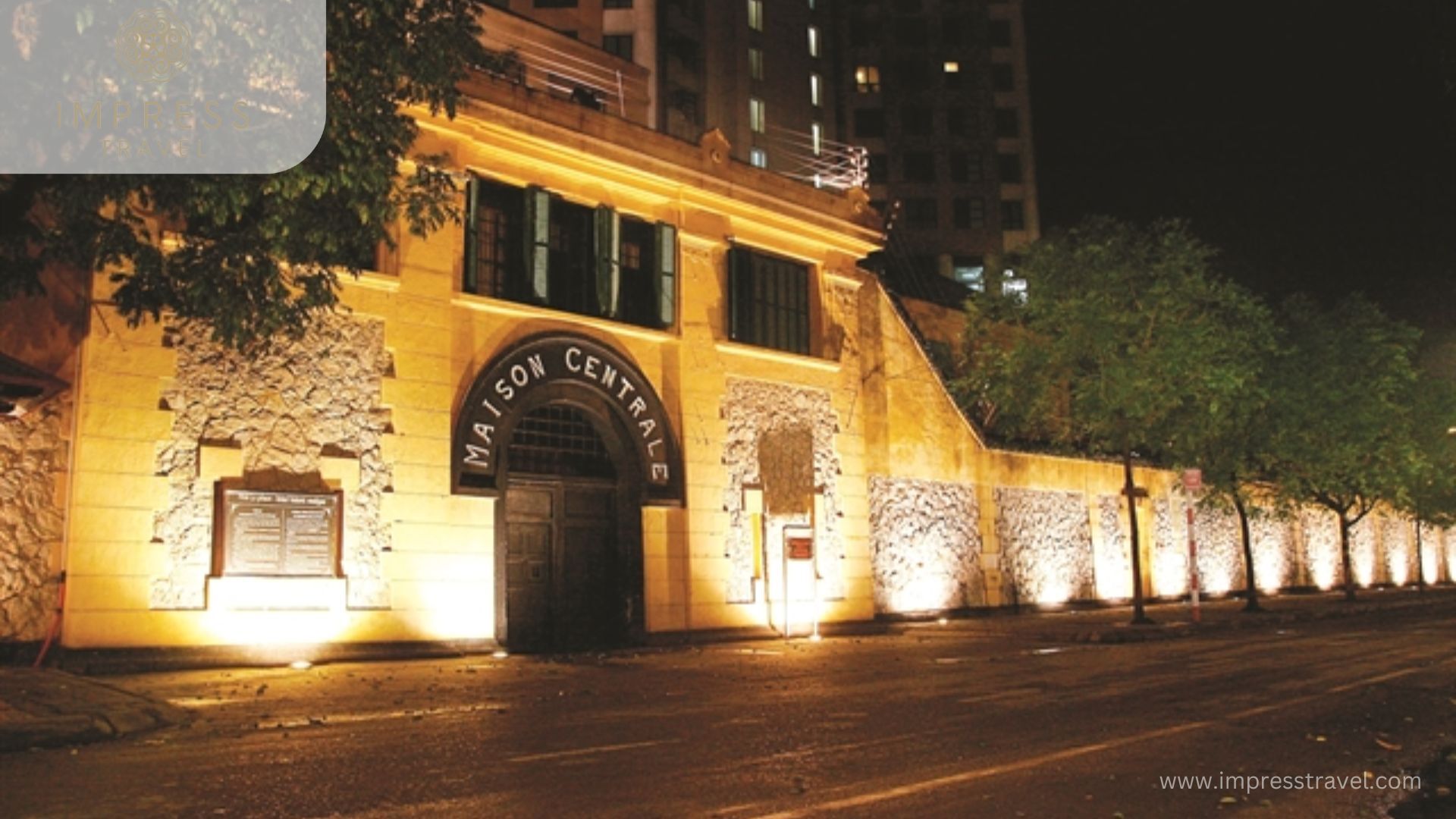Arranging a trip to Hanoi? Not to be missed are the Vietnam Military History Museum and Hoa Lo Prison, two important locations providing in-depth understanding of the turbulent and colorful past of the city. For those curious in Vietnam’s past and war relics, these sites are a must.

Hoa Lo Prison
One of the harshest prisons in history, Hoa Lo Prison, has seen the great resolve of Vietnamese revolutionaries and their sacrifice for the nation.
Among the top things on your bucket list to do in Hanoi while traveling, you should see Hoa Lo Prison in addition to sampling some amazing Vietnamese traditional cuisine. Visiting this historical artifact will provide you with a deeper understanding of the lives of Vietnamese revolutionaries during the First Indochina War. This page will give you fascinating details about this important historical place in Hanoi.
History of Hoa Lo Prison
Background of Hoa Lo Prison French colonists first constructed Hoa Lo Prison in the late 19th century to house political prisoners from Vietnam. American POWs infamously referred to it as the “Hanoi Hilton". It housed American POWs during the Vietnam War. As a museum now, it displays the terrible living circumstances endured by the prisoners as well as the unwavering will of those who opposed injustice.
Where is Hoa Lo Prison in Hanoi, Vietnam? How to get there?
Address: No. 1, Hoa Lo Street, Hoan Kiem District, Hanoi
A short 15-minute walk from Hoan Kiem Lake, Hoa Lo Prison enjoys a fantastic position in the center of Hanoi. From any location in the city, visitors may therefore readily reach this attraction. Among the widely used modes of transportation are the vehicle, motorbike, taxi, and public bus.
The bus numbers 2, 9, 40, and 49 all stop close to the prison if you would like to take one. Should you own a car, parking is accessible at the Hoa Lo Prison entrance.
Including holidays, Hoa Lo Prison is open daily from 8 a.m. to 5 p.m.
Admission to Hoa Lo Prison is fifty thousand VND each individual.
What to Explore
- Exhibits on Vietnamese Revolutionary Heroes: Discover the heroic men and women who battled to free Vietnam. Viewing these displays provides a potent teaching opportunity. It offers perspectives on the larger fight for Vietnamese independence in addition to highlighting individual tales of bravery and sacrifice. These exhibitions are an invaluable tool for students, historians, and anybody else interested in the history of Vietnam to comprehend the intricacies of the nation’s struggle for independence.
- Life of American POWs: Understand the experiences of American prisoners through personal items, letters, and photographs. Today, the Hoa Lo Prison Museum dedicates a significant portion of its exhibits to the American POW experience, preserving artifacts such as uniforms, personal items, and photographs. These displays serve as a poignant reminder of the hardships endured and the indomitable spirit of those who were imprisoned there.
- French Colonial Era: See the first guillotine and cells used under French control in -depth examination of the nation’s military history is offered by the Vietnam Military History Museum, which also promotes a better knowledge of Vietnam’s independence movement. A must-see for history buffs, it is a veritable gold mine of historical informationn. Including trips to Hoa Lo Prison and the Vietnam Military History Museum into your Hanoi itinerary will deepen your comprehension of Vietnamese history and culture. These places not only honour the past but also arouse a deep respect for the tenacity and bravery of the Vietnamese people. On your Hanoi war remains tour, make sure you see these important sites.
Value of Visiting Hoa Lo Prison
One is poignantly reminded of the bravery and resiliency of people who suffered incarceration when they visit Hoa Lo Prison. All visitors might benefit educationally from this space of contemplation on the battles for justice and freedom. What ought to be
Vietnam Military History Museum: A Journey Through Time

Vietnam Military History Museum
Thousands of displays, pictures, maps, and scale models utilized during Vietnam’s protracted and resilient history may be found in the Vietnam Military History Museum. Remember to include this location to your Hanoi trip itinerary if you are interested in learning about the tremendous achievements of the S-shaped nation.
Overview
Among Vietnam’s oldest museums is the 1956-founded Vietnam Military History Museum. Spreading across more than 10,000 square metres, it is close to the Hanoi Flag Tower. Showcasing items from antiquity to the present, the museum is devoted to Vietnam’s military history.
Information for guests of Vietnam Military History Museum
Save for Mondays and Fridays, the Vietnam Military History Museum is open to all visitors every day. Please find below the details:
- Hours of operation: 8:00 am to 11:30 am and 1:30 pm to 4:30 pm
- Entry to Vietnam Military History Museum is 40,000 VND per person.
You should also make note of the following museum rules in order to fully enjoy your visit:
- Move as directed by museum personnel, making room for the old and the disabled.
- Bring no firearms, explosives, combustible or poisonous materials, or contaminants into the museum.
- Leave all personal items, including purses and jewelry, at the left luggage office along with briefcases and rucksacks.
- Don’t eat, smoke, or litter in the display area.
- Never handle the equipment or exhibits.
Get information about the permitted filming and photo-taking locations by contacting the museum personnel.
Where is the Vietnam Military History Museum? How do I get there?
- Address: No. 28A, Dien Bien Phu Street, Ba Dinh District, Hanoi
The 10,000 square metre Vietnam Military History Museum is situated in the centre of Hanoi. Other well-known sights, such Uncle Ho’s stilt house, the Presidential Palace, Ho Chi Minh Mausoleum, and Botanical Gardens, are all within a short stroll away.
The museum is accessible by public transportation, motorbikes, and taxis, among other means. Numerous bus lines in Hanoi, including Nos. 9A, 18, 32, 41, and so on, pass the museum. For individuals who live further from the city center, the bus is thought to be the most affordable option. To get around independently, you can also get a bike from your hotel or other rental companies. Note that you ought to get the price and thoroughly inspect the car in advance.
What to Explore
- Historical Artifacts: The museum has an extensive collection of military hardware, weaponry, and uniforms from several eras. Numerous historical objects kept in the museum offer a concrete link to Vietnam‘s military past. These items show how military technology developed, how valiant the soldiers were, and what important incidents influenced the history of the country.
- Iconic Displays: View the remains of a Vietnam War-era MIG-21 jet fighter, a B-52 bomber, and tanks.
- Vietnamese Military Strategies: Find out what techniques and tactics Vietnamese armies have used throughout history. .
- Outdoor Exhibits:Take in the portion outside that features huge military vehicles and planes. Aerials, tanks, artillery, landmines, and other relics are among the items in the outdoor area at the base of Hanoi Flag Tower. The remains of airplanes that the Vietnamese army shot down are a feature of this region; one such aircraft is the tail of an American F-111A that plummeted straight into the earth.
Outstanding Displays
- Ho Chi Minh Campaign Room: Honors the last fight that resulted in South Vietnam‘s freedom in 1975. The interesting collection of exhibits at the well-designed museum are supported by English language descriptions. But the winners write the history, and the museum presents a very distorted picture that is consistent with communist ideology. This is clear from the way the artifacts look as well as the wording employed, which uses the standard “imperialist puppet troop" descriptions. Comparing the PAVN antiques to the ARVN and South Vietnamese exhibitions, which are kept clean and nearly new, the former always seem to be broken (like the scrap metal wrecks outside), run-down, or looking quite old and unkempt. The information on exhibit makes the museum well worth seeing, but don’t expect it to provide a true, impartial portrayal of the war.
- Dien Bien Phu Victory: An extensive display on the 1954 pivotal conflict against French colonial forces. The historic Dien Ben Phu triumph of May 7, 1954, was a spectacular culmination and a magnificent miracle of the Ho Chi Minh era in the history of national creation and defense in Vietnam. This historic turning point and decisive blow from this enormous win totally altered the never-ending conflict situation. The signing of the Geneva Agreement to put an end to the conflict and bring peace to Indochina followedimmediately after the triumph. This one triumph set up the circumstances and willpower for the Vietnamese people to defeat the US in their resistance battle, free the South, and at last unite the nation.
- Artillery Collection: An impressive display of artillery pieces used in various conflicts.
Value of Visiting the Museum
An in-depth examination of the nation’s military history is offered by the Vietnam Military History Museum, which also promotes a better knowledge of Vietnam‘s independence movement. A must-see for history buffs, it is a veritable gold mine of historical information.
Conclusion
Including trips to Hoa Lo Prison and the Vietnam Military History Museum in your Hanoi itinerary will deepen your comprehension of Vietnamese history and culture. These places not only honour the past but also arouse a deep respect for the tenacity and bravery of the Vietnamese people. These important sites shouldn’t be missed while touring the war relics of Hanoi.
Don’t forget to regularly follow our Facebook page and Website for more interesting information about traveling to Hanoi and to book Hanoi tours at the best prices.











































































